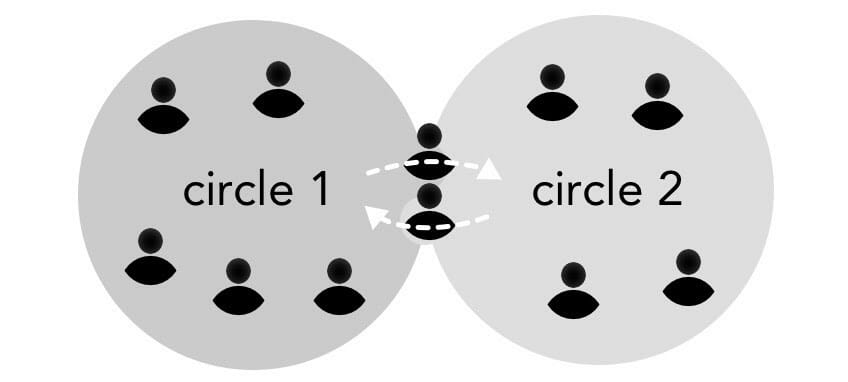
What is:
Double linking is the principle that two nested circles are connected by a double link: the leader is the top-down link, representing the next-higher’s circle’s voice in the circle but being a full member (with consent rights) in both circles. The delegate (or rep) is the bottom-up link, representing the circle’s voice in the next higher circle (but, again, being a full member of both circles).
Benefits:
It ensures flow of information and transparency in all directions. It also makes sure there is no power-over because two individuals who are members of both the higher and the lower circle have consent rights in both circles. The higher circle cannot make a decision over the lower circle because of double linking. Double linking also increases the level of information because two people filter information according to their perspective.
Double linking and flow of information
Circles in sociocracy are connected by at least two people serving in the roles of leader and delegate. We create a link in both directions, bottom-up and top-down. This has already been mentioned above when we talked about hierarchy. What we get when we have both links is circular hierarchy. It is not only top-down and not only bottom-up but both.
That still means that there is a hierarchy, in the sense that different layers of circles pay attention to different levels of specificity. The decision-making method of sociocracy is consent on all levels. That means that there cannot be over-powering of a super-circle over a sub-circle since the lower circle has two members that are members of the higher circle, each making their decisions by consent. Any one member could object to any proposal which means that the higher circle cannot make a decision that everyone in the lower circle is against.

Thus, hierarchy is not about power-over hierarchy but about stratification of specificity. Double-linking, applied in a bigger organization, creates a flow of information in all directions. We need this flow of information to make sure everyone and everything works well together. The leaders and delegates also serve as a filter – no one in an organization can (and wants to) hold all the information from all the circles. Only what is relevant is passed on so we can focus on what’s important.
What does double linking mean for the General Circle?
- The General Circle (GC) is the center of the flow of information for the operational level. (Note: that does not correlate with power. As a matter of fact, there can be GC that do not have authority to decide much at all because all authority lies in the department circles.) The General Circle consists of the leaders and delegates of all department circles.

- Every department circle has one leader and one delegate. With three department circles, this makes 6 people in the general circle (plus additional members from the mission circle). The GC holds the department circles accountable and supports them as a peer support. Imagine you are the leader of a circle. You want to have someone with whom to reflect on your circle, next steps, how things are going, etc. You will have the opportunity to talk about that in your General Circle. More than that, it is where the information gets shared. What are you working on? What does Department Circle 1 need to know about Department Circle 3? How can we support each other? Although the roles can blend into each other in reality, the idea is that the delegate reports from the department circle into the General Circle, while the leader – besides their other tasks of leading the circle—take the information from the GC into their department circles.


Leave a Reply
You must be logged in to post a comment.